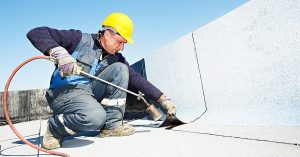What is a “cool roof”? It has nothing to do with how “cool” the top of your structure looks (although we can appreciate style points). Made from highly reflective tiles or shingles, a sheet covering, or a type of paint, cool roofs reflect more sunlight and absorb less heat than standard roofs. They can reduce energy bills, but you should always factor in the climate and other considerations before installing for this purpose.
 You know how a light-colored t-shirt keeps you cool on a sunny day, whereas a black t-shirt may leave you sweating more? That’s because of the reflective quality of sunlight. What we see as white is simply the combination of all possible visible light. Black absorbs everything coming from the sun, so it makes sense that a white roof will normally absorb less heat than a darker one.
You know how a light-colored t-shirt keeps you cool on a sunny day, whereas a black t-shirt may leave you sweating more? That’s because of the reflective quality of sunlight. What we see as white is simply the combination of all possible visible light. Black absorbs everything coming from the sun, so it makes sense that a white roof will normally absorb less heat than a darker one.
Black roofs can reach temperatures of 150 degrees or more during the height of summer in some climates. This warming effect means that people living and/or working under those roofs need to crank up the air conditioning just to keep things cool, even if they are not in the direct path of the sunlight while covered inside.
According to the U.S. Department of Energy, the benefits of a cool roof include:
- Lower electricity bills by virtue of not running air conditioning as much to achieve comfort
- Improved comfort in non-air conditioned spaces like covered patios or parking garages
- Potential for longer roof service life due to less extreme exposure to the sun’s harsh effects
Additionally, cool roofs can prevent power outages by lowering the peak electricity demand, lessen the “urban heat island effect” and reduce emissions of carbon dioxide, sulfur dioxide, nitrous oxides, mercury and other substances harmful to the atmosphere.
Commercial Cool Roofing Types
In many cases, roofs that were not natively cool roofs can be made into them by applying reflective coatings to protect the roof from ultraviolet (UV) light, while also offering some additional water protection. Several different types of roofing materials can be coated at the factory or in the field to make them more reflective.
You have to consider whether it is worth the cost to retrofit an existing roof with specialized heat-reflective material, replace it with a new one, or re-cover the roof with tile coating or another surface. The decision on whether to convert to a cool roof or leave things as they are becoming easier when an existing roof needs replaced soon or are in poor condition.
Black Single-Ply Membrane roofs can be reformulated or coated to make them reflective.
Built-Up Roofs can be made cool by substituting reflective marble chips or gray slag for dark gravel in a flood coat of asphalt. Reflective mineral granules or a factory-applied coating can be used rather than a dark coating on a mineral surfaced sheet. A cool coating may also be applied directly on top of a dark asphaltic emulsion coating.
Modified bitumen sheet membranes, typically made of plastic or rubber material, can be pre-coated with a cool roof at the factory.
Spray polyurethane foam roofs are usually already reflective when chemicals react to one another and combine to form a solid piece adhering to the roof.
On steep-sloped roofs, cool asphalt shingles can provide better solar reflectance from specially coated granules.
Painting a metal roof can increase its solar reflectance and thermal emittance, or we can apply reflective coatings.
Are the Cost and Energy Savings Enough to Warrant Installing a Cool Roof?
When calculating the energy savings you can expect from a cool roof, you need to factor in the climate and environment, the existing insulation of the roof, the type of roof you have, and whether the heating and cooling system under the roof works efficiently.
Some other considerations on your bottom line might be rebates and incentives, HVAC equipment downsizing, and extending the longevity of your roof.
The Oak Ridge National Laboratory and Lawrence Berkeley National Laboratory developed a roof savings calculator for commercial and residential buildings that can help to estimate financial impacts using whole-building energy simulations.
Is the Climate Right for Getting a Cool Roof?
It makes sense to get a cool roof in a more tropical climate where there’s very hot weather in the summertime, but in colder environments, there are benefits to absorbing heat on a sunny winter day.
In colder locations, moisture can also more easily accumulate through condensation. The U.S. Department of Energy warns “it is possible that cool roofs might be more susceptible to accumulating moisture than dark roofs of the same design.”
At Tennessee Roofing & Construction, Inc., we can advise you during pre-construction consulting on whether the warm climate here in the Deep South is suitable enough to reap sufficient economic rewards to justify a cool roof design or refit. We offer free estimates, and our services include engineering and design.
For additional information, call Tennessee Roofing and Construction at 423-842-8826 or contact us online.
Tennessee Roofing & Construction, Inc. provides roofing and construction services such in Chattanooga and around the Tennessee communities of Hixson, Cleveland, Dayton, Dunlap, Knoxville, Kimball, and South Pittsburg. We also service Dalton and Trenton Georgia, and Bridgeport Alabama.
Photo: © Dmitry Kalinovsky / 123RF Stock Photo
Blog © 2019 Tennessee Roofing & Construction | Hixson, TN 37343


